I nominate the above as understatement of the year, however young it be.I’ve read the Barling page and other sources that either deny briar used is over sixty years old or say it’s bad when it’s too old.
It sure isn’t fancy or pretty.
View attachment 277397
It Was the "Sap"
- Thread starter Briar Lee
- Start date
You are using an out of date browser. It may not display this or other websites correctly.
You should upgrade or use an alternative browser.
You should upgrade or use an alternative browser.
SmokingPipes.com Updates
Watch for Updates Twice a Week
- Status
- Not open for further replies.
Forgive my naivete, but, if they are boiling the briar to remove sap, then curing the briar, how is there still sap oozing out ?
As for quality:
This thread has caused me to rethink my pipes. I have suspected for some time that I had the finest quality pipes to the exclusion of all others. I did some research on the brands and history and sure enough they either say 'Finest quality briar' or 'Finest pipes in the world' or 'the mark of highest standard for pipes on a global basis' or 'legacy of highest craftsmanship' or 'preservation of tradition' or 'perfection in quality, style and craftsmanship'. So I know its true and have confirmed it. I guess I'm just lucky ...
As for quality:
This thread has caused me to rethink my pipes. I have suspected for some time that I had the finest quality pipes to the exclusion of all others. I did some research on the brands and history and sure enough they either say 'Finest quality briar' or 'Finest pipes in the world' or 'the mark of highest standard for pipes on a global basis' or 'legacy of highest craftsmanship' or 'preservation of tradition' or 'perfection in quality, style and craftsmanship'. So I know its true and have confirmed it. I guess I'm just lucky ...
Quoting my post has scant to do with what you wrote. Please check attributions!I nominate the above as understatement of the year, however young it be.
The price of sawmill timber fluctuates according to demand. Right now in the Ozarks foothills red cedar seems in demand. I see red cedar logs that must be ancient as I drive from Humansville to Dunnegan all piled up at the Amish mills.
My father died in 1971 and there’s a patch of maybe a hundred cedars that have grown where there was thin pasture by Turkey Creek when my father milked cows. My father burned that pasture at least once a year, and when he died the cedars took it.
It’s the last patch of cedars on the place.
My Amish renter has cut all the rest down at ground level and burned them.
A few years ago I had a logger estimate what my cedars were worth and he said about seven dollars each, if they were a certain size, and nothing at all if smaller.
If there are a hundred and my share is half, then $350 and I loose all my cedars.
It’s actually neat to explore the cedar patch. Not a blade of grass, a full canopy of cedars above, and you can walk around bent over and see daylight all around. It’s a natural windbreak for my renter’s cows to shelter in during cold weather.
I hate cedars. But I like those, more than $350.
If those were mature white oaks stave bolt size they’d bring $200 each. I don’t like that patch $10,000 worth.
If they were veneer walnut trees they’d bring $2,000 each, or more.
The market for heather burls from the Mediterranean is about one hundred times less than eighty years ago.
I’ll bet their mills are damned particular what they buy, over there.
Last edited by a moderator:
Forgive my naivete, but, if they are boiling the briar to remove sap, then curing the briar, how is there still sap oozing out ?
As for quality:
This thread has caused me to rethink my pipes. I have suspected for some time that I had the finest quality pipes to the exclusion of all others. I did some research on the brands and history and sure enough they either say 'Finest quality briar' or 'Finest pipes in the world' or 'the mark of highest standard for pipes on a global basis' or 'legacy of highest craftsmanship' or 'preservation of tradition' or 'perfection in quality, style and craftsmanship'. So I know its true and have confirmed it. I guess I'm just lucky ...
Everything anybody ever wrote about briar for pipes talks about boiling, or soaking in ponds, or steaming to remove sap.
The burls are wet when dug, a living part of a plant.
And from what little was written about Algerian they hated it needed longer curing times. Time is money.
Then after it’s boiled or soaked or steamed it needs dried out, about a year an inch seems average. Eventuality the wood gets the same average humidity as the storage barn.
Then after it’s dried as much as it will dry, the best makers like Castello age it another ten years, or more, the more the better.
Some makers like Radice oil cure the briar again after they get it.
Some part of all the time and trouble spent to age briar is to harden it so it can be worked but a lot is for smoking quality.
I’m smoking a Marxman Super Briar that’s such an early pipe it has a crown (or outline of Algeria?) between Imported and Briar. I just can’t count the lines on it, it was ancient briar. It won’t take stain, it’s so close grained, yet it soaks up beeswax. If you look close it’s not symmetrical, it was hand turned.
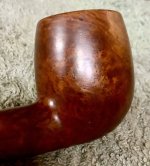
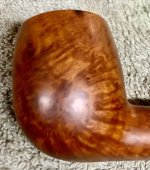
Before the 1937 Marxman 400 that $15 size Marxman was the most expensive factory pipe on the planet.
Wow, is it a good smoker. It won’t get hot, smokes dry, and tastes divine, if you like strong pipes.
The exact reasons why I don’t know, but there is lots of “good sap” in there.
Look at the black dots, the size of pin holes.

Marx sold a lot of $15 pipes in a world where a quarter bought a decent briar pipe, is all I know for sure.
Last edited:
I would say if you are tasting sap then your pipe isn't top quality.
When you buy a brand new briar pipe, take it out of the box, and fire it up, nine times out of ten by the bottom of the bowl, the pipe has got hot, it may snap or crackle, it sweats, and it tastes like -briar sap-.
Sometimes they don’t seem to need break in, but most pipes do.
And the worst, nastiest, most painful part of break in consists of the last quarter inch and the vast majority of my used pipes are not smoked even once allllll the way down, to where ashes come through the draft hole.
Which of course, I invariably do finish the chore of break in.
Maybe five per cent (?) of pipes not made of Algerian briar are dynamite smokers on the first bowl and get better at the bottom. The last one I got in that did that was a 5 point Two Star Lee Poker I filled with Half and Half at Gardner Cemetery in Wheatland and was still savoring at Humansville where I bought them out of $3.50 pouches of Half and Half.
Then I looked at the bottom of the pipe and it had colored a dark reddish brown. I thought I’d toasted the briar, but it was just coloring. There’s sort of a black line above the bottom and the flat bottom of the Poker has colored all the way back to the stem.
I keep that Lee Poker in my car. It still tastes good, although there’s no -briar sap- taste and it no longer gets so hot I’m worried I’ll toast it.
All Lees have a sugary sweet taste in break in and that’s gone too.
What is that -briar- taste we experience during break in unless it’s from -sap-? It’s not from the tobacco, because keep smoking and that -briar- taste leaves. It’s not the sweet oils used for oil curing because that taste fades away, too.
What Marx, and Dunhill (for Shell Briar) and Mincer did in order to sell high dollar pipes was select ancient Algerian briar, as hard as it was to work into pipes, and use it.
Marx turned the gnarly appearance of Algerian briar into a selling point to women who wanted their escorts or their sons or brothers to be rugged outdoor men of action.
These were the Isotoner gloves, Egyptian cotton shirts, and pure silk ties of their day, an accessory she had him buy or she bought for him, when they were in style.
1946
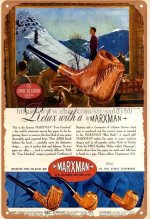
1947

But all Marx ads also refer to the well seasoned old briar used, that made a Marx last for years,,,,no mentioning the Algerian briar would color, not even stamping Algerian on the pipe, at all.
They all have first smoke break in and they don’t get hot on that one, just a whiff of -briar- at the bottom, that tastes good.
After that a Marx gets better and better with use, likely to a point somewhere when the tars totally saturate the briar.
There is some organic material inside Algerian briar, that I call sap, that the heat of the ember releases, and subtly flavors the smoke a little.
It also produces beautiful coloring on the outside if beeswax is applied, faster, but eventually they all look like this.

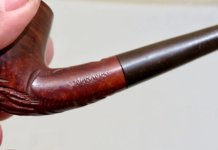
If you bought that A sized bent pipe the cake will just fall off when scraped. It would clean up to new. The stem could be heated and rebent.
It is a dynamite smoker, too. Look at the lines across it.
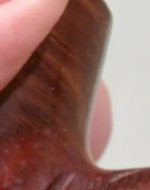
There’s something inside that makes it that way, whatever name you give it.
Sometimes they don’t seem to need break in, but most pipes do.
And the worst, nastiest, most painful part of break in consists of the last quarter inch and the vast majority of my used pipes are not smoked even once allllll the way down, to where ashes come through the draft hole.
Which of course, I invariably do finish the chore of break in.
Maybe five per cent (?) of pipes not made of Algerian briar are dynamite smokers on the first bowl and get better at the bottom. The last one I got in that did that was a 5 point Two Star Lee Poker I filled with Half and Half at Gardner Cemetery in Wheatland and was still savoring at Humansville where I bought them out of $3.50 pouches of Half and Half.
Then I looked at the bottom of the pipe and it had colored a dark reddish brown. I thought I’d toasted the briar, but it was just coloring. There’s sort of a black line above the bottom and the flat bottom of the Poker has colored all the way back to the stem.
I keep that Lee Poker in my car. It still tastes good, although there’s no -briar sap- taste and it no longer gets so hot I’m worried I’ll toast it.
All Lees have a sugary sweet taste in break in and that’s gone too.
What is that -briar- taste we experience during break in unless it’s from -sap-? It’s not from the tobacco, because keep smoking and that -briar- taste leaves. It’s not the sweet oils used for oil curing because that taste fades away, too.
What Marx, and Dunhill (for Shell Briar) and Mincer did in order to sell high dollar pipes was select ancient Algerian briar, as hard as it was to work into pipes, and use it.
Marx turned the gnarly appearance of Algerian briar into a selling point to women who wanted their escorts or their sons or brothers to be rugged outdoor men of action.
These were the Isotoner gloves, Egyptian cotton shirts, and pure silk ties of their day, an accessory she had him buy or she bought for him, when they were in style.
1946

1947

But all Marx ads also refer to the well seasoned old briar used, that made a Marx last for years,,,,no mentioning the Algerian briar would color, not even stamping Algerian on the pipe, at all.
They all have first smoke break in and they don’t get hot on that one, just a whiff of -briar- at the bottom, that tastes good.
After that a Marx gets better and better with use, likely to a point somewhere when the tars totally saturate the briar.
There is some organic material inside Algerian briar, that I call sap, that the heat of the ember releases, and subtly flavors the smoke a little.
It also produces beautiful coloring on the outside if beeswax is applied, faster, but eventually they all look like this.


If you bought that A sized bent pipe the cake will just fall off when scraped. It would clean up to new. The stem could be heated and rebent.
It is a dynamite smoker, too. Look at the lines across it.

There’s something inside that makes it that way, whatever name you give it.
Last edited:
When you buy a brand new briar pipe, take it out of the box, and fire it up, nine times out of ten by the bottom of the bowl, the pipe has got hot, it may snap or crackle, it sweats, and it tastes like -briar sap-.
Sometimes they don’t seem to need break in, but most pipes do.
And the worst, nastiest, most painful part of break in consists of the last quarter inch and the vast majority of my used pipes are not smoked even once allllll the way down, to where ashes come through the draft hole.
Which of course, I invariably do finish the chore of break in.
Maybe five per cent (?) of pipes not made of Algerian briar are dynamite smokers on the first bowl and get better at the bottom. The last one I got in that did that was a 5 point Two Star Lee Poker I filled with Half and Half at Gardner Cemetery in Wheatland and was still savoring at Humansville where I bought them out of $3.50 pouches of Half and Half.
Then I looked at the bottom of the pipe and it had colored a dark reddish brown. I thought I’d toasted the briar, but it was just coloring. There’s sort of a black line above the bottom and the flat bottom of the Poker has colored all the way back to the stem.
I keep that Lee Poker in my car. It still tastes good, although there’s no -briar sap- taste and it no longer gets so hot I’m worried I’ll toast it.
All Lees have a sugary sweet taste in break in and that’s gone too.
What is that -briar- taste we experience during break in unless it’s from -sap-? It’s not from the tobacco, because keep smoking and that -briar- taste leaves. It’s not the sweet oils used for oil curing because that taste fades away, too.
What Marx, and Dunhill (for Shell Briar) and Mincer did in order to sell high dollar pipes was select ancient Algerian briar, as hard as it was to work into pipes, and use it.
Marx turned the gnarly appearance of Algerian briar into a selling point to women who wanted their escorts or their sons or brothers to be rugged outdoor men of action.
These were the Isotoner gloves, Egyptian cotton shirts, and pure silk ties of their day, an accessory she had him buy or she bought for him, when they were in style.
1946
View attachment 277583
1947
View attachment 277586
But all Marx ads also refer to the well seasoned old briar used, that made a Marx last for years,,,,no mentioning the Algerian briar would color, not even stamping Algerian on the pipe, at all.
They all have first smoke break in and they don’t get hot on that one, just a whiff of -briar- at the bottom, that tastes good.
After that a Marx gets better and better with use, likely to a point somewhere when the tars totally saturate the briar.
There is some organic material inside Algerian briar, that I call sap, that the heat of the ember releases, and subtly flavors the smoke a little.
It also produces beautiful coloring on the outside if beeswax is applied, faster, but eventually they all look like this.
View attachment 277596View attachment 277597
If you bought that A sized bent pipe the cake will just fall off when scraped. It would clean up to new. The stem could be heated and rebent.
It is a dynamite smoker, too. Look at the lines across it.
View attachment 277605
There’s something inside that makes it that way, whatever name you give it.
Grind up one of those Algerian Briars into dust and smoke it. I’m sure it’ll be just as sweet and delicious. From the sap, you know
WerewolfOfLondon wrote:
Actually, I believe that he'd rather have another Marxman pipe!
Fighting for the poor, I for one salute you. Give that man a ceegar.
Actually, I believe that he'd rather have another Marxman pipe!
Grind up one of those Algerian Briars into dust and smoke it. I’m sure it’ll be just as sweet and delicious. From the sap, you know
My Scotch upbringing has me still picking up pennies off the street.
But I don’t mind using steel wool on a $20 pipe to get the blond briar back.
Algerian briar is about like high grade stainless steel to resist permanent darkening. The same briar that soaks up wax, can be scratched with a fingernail, shaped with a pocket knife, just won’t burn and won’t hold carbon cake.
Some of it sheds caking to a greater degree, and this Big Boy Super Grain is at the top of the spectrum.
That rim was coal black a minute ago. If I kept on it would be almost white.
I can’t explain this worth a hoot.
But they don’t permanently color. The color is a whisker deep.
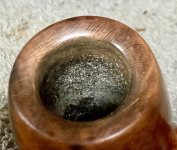
WerewolfOfLondon wrote:
Actually, I believe that he'd rather have another Marxman pipe!
Forty years ago Social Security judges demanded and expected and rewarded a two hour dog and pony show.
But you couldn’t just make things up.
Her mother actually was, truly, the barmaid in the honky tonk downstairs.
Her husband could have been the model for Skid Row Joe.
And she really did get fired for incompetence after two weeks as a library assistant on a government project for the hard core unemployed.
The typical case in 1997 involved a medical file about five hundred or more pages the judges had to try to read all of it. That record was about ten pages and there was a sticky note beside
Rule out co dependency syndrome
It took an educated hillbilly to fill in the two hours with Dallas Fraizer songs.
The stockyards weren’t far off, from the Bob Dole Federal Courthouse.
One little girl grew up in an apartment over a bar in the stockyard district where the men with hungry eyes laughed and her mother waited tables, and she could hear it upstairs.
She was stuck in the only life she’d known.
I love the beveled inner rim on this pipe. For some reason super squared edges on a smooth pipe aren’t as appealing to me.
It’s not sap.
What colors Algerian briar?
Custombilt pipes, which pre date Marx pipes, got the same coloring.
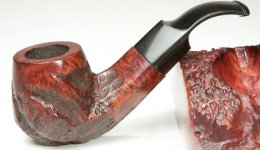

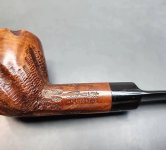
Tom Howard sold Aged Algerian pipes.
Here’s mine.
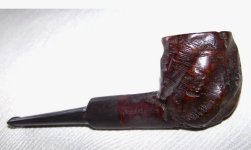
It’s a reddish brown hue that comes from oils, resins, tannins—-some kind of sap—-the burl produced when it was alive.
Cheap Algerian briar pipes may have colored like the high dollar ones did, I don’t know.
But high dollar Algerian pipes color from something, inside the briar.
Last edited:
The same thing that colors meerschaum. The combination of tobacco resin and smoke, and the moisture that results from smoking it.What colors Algerian briar?
My guess as far as why your pipes are “coloring” so quickly is that it has much more to do with your finish stripping and re-oiling process. I don’t think it’s anything in the briar, aside from already existing coloration that is present from years of smoking before it arrived on your porch. I think that existing coloration that has permeated the wood in years past is just being highlighted and made more visible by your re-finishing.
If I were a betting man, I’d wager that if you bought a new, fresh stummel (from Ropp let’s say) and went through your usual process with it, it would not “color” anywhere near as rapidly, as the stummels are not already completely saturated by years and years of the byproducts of tobacco combustion in the chamber.
Last edited:
The same thing that colors meerschaum. The combination of tobacco resin and smoke and the moisture that results from smoking it.
Although its porous, unlike meerschaum briar forms a more or less solid wall between the ember and the outside.
If you grind down the top of a colored Algerian briar pipe it’s white inside.
If it’s smoke, the inner core would turn brown like a cigarette filter.
And while a meerschaum smokes cool it never has an extra whang of spicy taste like hot Algerian imparts.
It is a mystery I will grant you.
But it’s from the inside, not your hands,
Yes, oils and resins from the tobacco, not the wood.It’s a reddish brown hue that comes from oils, resins
Yeah, it would appear lighter, just like your pipes do after you remove the original finish when they arrive. If you then re-applied a new finish, oil, or wax, they would appear darker again, just like the outside of your pipe does when you do so.If you grind down the top of a colored Algerian briar pipe it’s white inside.
@Briar Lee do you actually believe the stuff your saying? And please no anecdote.
I find everything you post very enjoyable, but a lot of times it is complete nonsense. I’m sure you’d be a hoot with a few beers.
I find everything you post very enjoyable, but a lot of times it is complete nonsense. I’m sure you’d be a hoot with a few beers.
- Status
- Not open for further replies.








